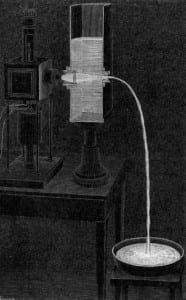Lunch Hour Lecture: The illusion of infinity – is there a limit to optical fibre bandwidth?
By Thomas Hughes, on 17 February 2016

Heliograph in use via Wikimedia Commons.
Professor Polina Bayvel (UCL Electronic & Electrical Engineering) opened her Lunch Hour Lecture with the worrying fact that our internet capacity is finite and we are fast approaching that limit. What can we do to find new capacity so that our optical fibre can manage the growth of the coming decades?
Professor Bayvel explained that optical communications have been a part of human communications for millennia. Fire and smoke signals, heliographs and Aldis lamps (which both use flashes of light to signal) are all forms of communication called “free space communications”. These were important for our predecessors’ long distance communications, but with the major flaw that they didn’t work on cloudy or otherwise poor visibility days.
Modern communications are almost entirely built around optical fibre networks. These work by bouncing beams of light along glass cables. The light is received and decoded into whatever information was requested. They allow huge amounts of data to travel long distances, and with the help of repeaters which receive the signal and rebroadcast it, can travel around the whole world.
From light and water to optical fibres
In 1870, the concept of total internal reflection, which makes optical fibres work, was demonstrated by the Swiss physicist Jean-Daniel Colladon by shining a light into a closed box of water. When the water drains out through a small hole on the opposite side of the box, the light bounces along the stream of water creating a stream of light (see image).

Illustration by Jean-Daniel Colladon.
Colladon wanted to use this technique to create unique lighting at a performance of the opera Faust, and his paper and the results of his experiments were not widely disseminated.
Nearly a hundred years later, in 1966 the British scientist Charles Kao created the first optical fibres based on this phenomenon for which he won the Nobel Prize in 2009. While these first fibres had problems with signal degradation, solutions were quickly found. In 1977 BT laid the first optical fibre cable between Stevenage and Hitchin, with repeaters every 3km (now they are every 50-100km).
In 1992 total communications traffic was around 100GB per day, but in 2016 it is around 132EB per day or around 1320000000 times more data. Until recently infrastructure had been growing to meet demand, but we have begun to reach the fundamental ceiling of current optical fibre technology so as the possibilities the internet offers continue to grow we could run out of capacity.
For example, total internet traffic has doubled in the last 12 months, but total capacity has only doubled in 18 months, and its growth is continuing to slow.
What can we do?
This is the focus of Professor Bayvel and her team’s research. While a certain amount of capacity can be created by simply adding more cables, changing the properties of the light and the way it is transmitted can create a longer term solution and greatly increase capacity.
Currently optical fibres use a whole range of coloured lights to transmit data although it just consists of on and off, or 1s and 0s. Professor Bayvel’s team has been using techniques pioneered on wireless networks, where capacity is even more limited, to change the properties of light itself within the optical fibres.
These techniques allow the team to change the variables of the light in many ways. This would allow a much greater density of information to be sent, improving speed and capacity.
The problem however is that changing the properties of light in so many ways can cause signal degradation as the original message becomes lost in the complex web of changing variables, especially over long distances. Professor Bayvel’s team has made important strides in this area by implementing a variety of decoding techniques that allow the original message to be retrieved.
The team recently passed an important milestone by transmitting at a record-breaking 1.125Tb per second of data, or 46875 times faster than the current definition of high speed broadband to the home. With which you could download every season of the television show Game of Thrones in 1 second.
The next goal is to do this over a distance of 9,000km, which is the distance that a cable would need to cross the Atlantic Ocean.
The EU commission has offered a reward of €500,000 to the group that can achieve the longest distance with the highest data capacity, and Professor Bayvel’s team hopes to win this prize.
Professor Bayvel’s team offers hope that we can continue to build capacity by finding new solutions to the capacity problems created by the rapid growth of the internet. If we can’t continue to build capacity it risks not only holding back socio-economic growth, but people’s ability to download Game of Thrones, which is a terrifying thought.
 Close
Close

